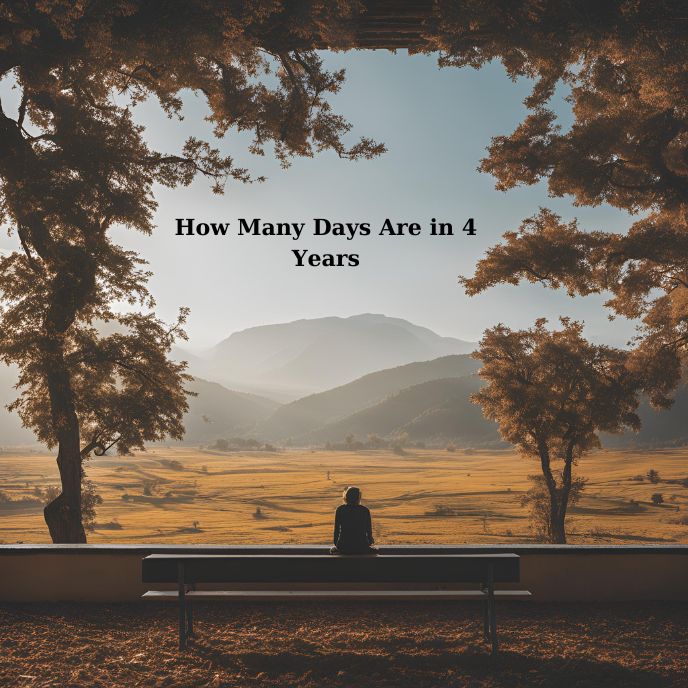Calculating days over multiple years is more relevant than it might initially seem. Whether you’re planning a long-term project, setting event cycles, or even organizing a seasonal restaurant calendar, understanding how many days are in specific time spans can be crucial. The answer to “how many days in 4 years?” isn’t simply 1,460 (365 days x 4), because the calendar we use has an extra leap day every four years. Here, we’ll dive into the precise calculation and how understanding these cycles can be useful—even in the culinary world.

How Many Days Are in 4 Years?
Calculating the total days in four years is simple once you factor in leap years, which add an extra day to the calendar every four years. This is due to the way the Gregorian calendar adjusts for the Earth’s rotation around the sun, which takes about 365.25 days, not exactly 365.
Leap Years vs. Regular Years
A regular year has 365 days, while a leap year has 366 days. This extra day falls on February 29 and happens every four years to keep the calendar year aligned with the Earth’s orbit. Over a four-year period, you’ll have three regular years and one leap year.
Simple Calculation of Days in Four Years
To get an accurate count:
- 3 years x 365 days = 1,095 days
- 1 leap year x 366 days = 366 days
- Total for 4 years = 1,095 + 366 = 1,461 days
So, the total days in four years, accounting for a leap year, is 1,461 days.
Why Is Leap Year Important in Planning?
For many industries, including the culinary world, understanding how many days fall within a specific time frame can be crucial for planning cycles. Leap years impact everything from annual budgeting to event scheduling. If you’re managing seasonal menus, long-term supply contracts, or holiday bookings, being aware of time increments can prevent scheduling mishaps.
In fact, for restaurants like Fronteras KC, this knowledge can shape how we plan our special events and seasonal offerings, ensuring that we keep pace with the calendar and don’t miss out on opportunities due to simple miscalculations.
The History Behind Leap Years
Leap years originated as a way to keep the calendar year aligned with the Earth’s seasons, which don’t fit neatly into a 365-day schedule. Introduced in the Julian calendar, the leap year concept was refined with the Gregorian calendar we use today, which excludes leap years every 100 years unless the year is also divisible by 400. This way, the calendar remains accurate without drifting from the actual solar year over centuries.
Practical Culinary and Restaurant Applications
In the culinary world, timing is everything. Calculating specific time spans accurately allows restaurant managers and chefs to make decisions about:
- Seasonal Menu Planning: We can align seasonal produce offerings or limited-time menus based on yearly cycles.
- Event Coordination: Leap years can subtly shift days around, impacting holiday schedules or seasonal events.
- Supply Ordering: Planning orders and adjusting inventory for seasonal items is essential, especially over long spans.
Having this knowledge ensures that our offerings stay fresh and align perfectly with the seasons and the needs of our customers.
Calculating Days Beyond Four Years
Sometimes, we need to plan well beyond four-year cycles. To calculate the number of days over a longer period, such as eight or twelve years, simply repeat the cycle:
- Every four-year cycle has 1,461 days.
- Multiply the number of four-year cycles by 1,461 to get the total.
For example:
- 8 years = 1,461 x 2 = 2,922 days
- 12 years = 1,461 x 3 = 4,383 days
This is a quick way to break down time spans over multi-year plans.
FAQ: Common Questions About Leap Years and Days in Four-Year Cycles
Q: Why does a leap year have 366 days?
A: Leap years add an extra day to keep the calendar year in sync with the Earth’s orbit. This extra day, February 29, occurs every four years.
Q: How can I calculate days across multiple years?
A: Multiply each year by 365 and add one day for each leap year. For example, 4 years = 1,461 days (3 x 365 + 1 x 366).
Q: Do all countries use leap years?
A: Most countries using the Gregorian calendar follow the leap year rule, so they observe the 366-day cycle every four years.
Q: How many days are in 100 years?
A: Over 100 years, there are approximately 36,524 days, accounting for most but not all leap years, following the rule for excluding certain leap years (e.g., years divisible by 100 but not by 400).
Final Thoughts
Knowing exactly how many days are in four years is more than a trivia fact—it’s useful knowledge that impacts a variety of professional fields, including our own here at Fronteras KC. Being precise about these time spans allows us to plan menus, events, and customer experiences with confidence, ensuring we’re aligned with the rhythm of the seasons and the needs of our community.

Related Articles :